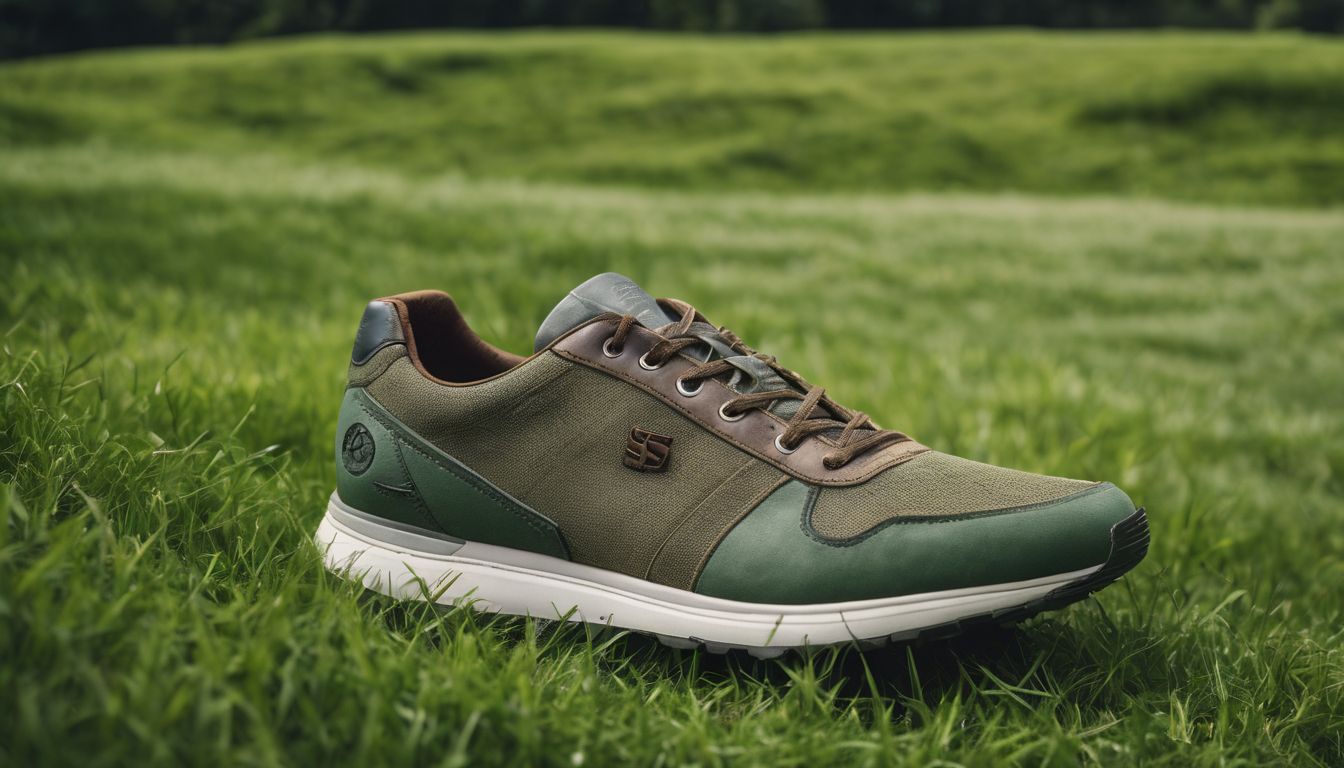We all endeavour to make decisions that honour our commitment to the planet, yet sourcing genuinely sustainable footwear can often feel like an uphill trek. Much like you, we understand this journey well; conscious of a forecast that sees the global sustainable footwear market flourishing to an impressive USD 11.8 billion come 2025.
Let us be your compass in navigating the verdant landscape of eco-conscious cobbling, ensuring your footprints upon our Earth are as gentle as they are stylishly discerning. Step into a world where green choices and quality go hand in hand – let’s explore together!
Key Takeaways
- The global sustainable footwear market is rapidly expanding, with projections indicating a rise to USD 11.8 billion by 2025.
- Eco-friendly footwear includes options for athletic and non-athletic shoes made from recycled, biodegradable or sustainably sourced materials.
- Consumer awareness and the demand for ethically produced items are key drivers in the growth of the market, while high production costs and limited availability of sustainable materials pose challenges.
- Sustainable shoe options are widely accessible through specialty shops, supermarkets/hypermarkets, and online stores.
- Regional markets like North America, Europe, Asia-Pacific, Middle East & Africa, and Latin America each show unique trends towards increasing adoption of eco-friendly footwear.
Overview of the Sustainable Footwear Market
The sustainable footwear market is defined by the use of eco-friendly materials and ethical manufacturing processes. It has seen steady growth in recent years, driven by increasing consumer awareness and demand for environmentally friendly products.
This segment of the shoe industry offers a variety of options from athletic to non-athletic shoes that appeal to a wide range of demographics.
Definition
Eco-friendly footwear stands for shoes designed with the environment in mind. These products minimise their carbon footprint by using materials that are either recycled, biodegradable or sustainably sourced.
We consider every stage of the shoe’s life cycle, from production to disposal, ensuring a lower impact on our planet.
In embracing green shoes, we’re not just wearing a trend; we’re supporting an eco-conscious choice that promotes sustainability in fashion. By choosing ethical footwear, whether it’s vegan boots or sneakers made from reclaimed materials, we actively contribute to reducing waste and conserving natural resources.
It’s more than style—it’s about making responsible decisions that align with our values for conservation and environmental care.
Size and Growth Trends
We understand the importance of conserving our planet, and as we explore the sustainable footwear market, it’s clear that its growth is a testament to the shifting priorities of consumers worldwide. The market is expanding rapidly as more individuals commit to eco-friendly choices.
| Year | Market Size (USD Billion) | Growth Rate (%) |
|---|---|---|
| 2020 | 7.5 | 5.2 |
| 2021 | 8.0 | 6.7 |
| 2022 | 8.7 | 8.8 |
| 2023 (Projected) | 9.6 | 10.3 |
| 2024 (Projected) | 10.5 | 9.4 |
| 2025 (Projected) | 11.6 | 10.5 |
This table succinctly captures the increase in market size and the accelerating growth rate, indicating that the trend towards sustainable footwear is not just a fleeting fad but a profound shift in consumer behaviour. We’re witnessing an era where our choices at the checkout can lead to significant environmental impact reduction. As we continue to advocate for responsible consumption, this burgeoning market is one we watch with great interest.
Market Dynamics
The sustainable footwear market is being driven by an increased awareness of environmental issues and the need for ethical products. These factors are creating opportunities for growth in the industry.
Drivers
The sustainable footwear market is driven by various factors that are shaping the industry. These drivers include:
- Growing consumer awareness and demand for eco – friendly products such as vegan footwear and biodegradable shoes.
- Increasing adoption of sustainable materials like recycled rubber and organic cotton, driving innovation in sustainable footwear production.
Restraints
The sustainable footwear market faces several challenges and limitations that impact its growth and adoption. These restraints include:
- Limited availability of eco – friendly materials, making it harder to produce sustainable footwear on a large scale.
- Higher production costs due to the use of environmentally friendly materials and ethical manufacturing processes, leading to higher retail prices for sustainable footwear.
- Lack of awareness among consumers about the environmental impact of traditional footwear, hindering their willingness to switch to sustainable options.
- Resistance from some traditional manufacturers and retailers to embrace sustainability practices, creating barriers for the widespread acceptance of eco-friendly footwear.
Opportunities
We see opportunities in the eco-friendly footwear market for environmentally conscious individuals who seek sustainable options. These opportunities include:
- Incorporating innovative, eco-friendly materials such as recycled rubber, organic cotton, and plant-based alternatives to reduce the environmental impact.
- Collaborating with ethical manufacturers to develop and produce sustainable footwear lines that meet consumers’ demands for fashionable and responsibly made shoes.
- Utilising advanced technology to create durable, long-lasting footwear that promotes a circular economy by encouraging repair and recycling.
- Promoting awareness through marketing campaigns to educate consumers about the benefits of sustainable footwear, hence driving demand for these products.
- Implementing transparent supply chain practices to ensure fair labour conditions and reduce carbon emissions associated with transportation.
- Engaging in partnerships with retailers to expand the accessibility of sustainable footwear options across various distribution channels and regions.
- Investing in research and development to continuously improve the sustainability of shoe manufacturing processes while keeping up with evolving consumer preferences.
Types of Sustainable Footwear
Athletic and non-athletic footwear are two main categories of sustainable shoes. Athletic eco-friendly footwear includes running, hiking, and training shoes designed to be both durable and sustainable.
Non-athletic options include casual, dress, and work shoes made from environmentally friendly materials for a wide range of occasions.
Athletic
Athletic footwear made from sustainable materials is gaining popularity among environmentally conscious consumers. Brands are investing in eco-friendly technologies to produce athletic shoes that minimise environmental impact, with a focus on using recycled and biodegradable materials.
The demand for sustainable athletic footwear is being driven by increasing awareness about the environmental footprint of traditional shoe production methods, leading to a shift towards eco-conscious alternatives.
Manufacturers are also incorporating ethical practices into their supply chains to ensure fair labour conditions and reduced carbon emissions in the production process.
Consumers can now find a wide range of sustainable athletic footwear options, including running shoes, trainers, and walking boots, providing both performance and environmental benefits.
Non-athletic
Non-athletic sustainable footwear includes a wide variety of options such as stylish sneakers, casual flats, boots, and dress shoes that are designed with eco-friendly materials. These non-athletic footwear choices not only fulfill the fashion needs of environmentally conscious individuals but also contribute to the conservation of resources and reduction in environmental impact.
The growing demand for ethical shoe market alternatives has paved the way for innovative designs and materials in non-athletic sustainable footwear.
Moving on to “Target Demographics,” it is essential to understand the preferences and requirements of men, women, and children in this context.
Target Demographics
The sustainable footwear market caters to a wide range of demographics, including men, women, and children. With a growing awareness of environmental issues, there is a demand for eco-friendly footwear across all age groups.
Men
Men are a key demographic in the sustainable footwear market, with a growing interest in eco-friendly and ethically produced shoes. As more men seek environmentally friendly options, there is an increasing range of sustainable footwear tailored specifically to their preferences and needs.
Brands have responded to this demand by offering stylish and durable choices that use recycled materials, sustainable production methods, and ethical sourcing practices.
These ecoconscious consumers can now find athletic and non-athletic styles that align with their values while also meeting their fashion and performance expectations. With the availability of sustainable footwear for men across various distribution channels, including online stores and specialty shops, it has become easier for them to make environmentally responsible choices without compromising on style or quality.
Women
Moving on to the target demographic of women, it’s important to note that sustainable footwear options are increasingly available for eco-conscious female consumers. Women have a wide range of choices when it comes to eco-friendly footwear, from stylish trainers and sandals made from recycled materials to ethically produced boots and flat shoes.
Sustainable shoe brands are recognising the demand for environmentally friendly fashion among women and are offering a variety of designs that cater to different tastes and preferences.
Consumers seeking eco-friendly footwear can find an array of options, including those made from sustainable materials such as recycled plastics, organic cotton, or natural rubber. With the growing emphasis on ethical consumption and environmental responsibility, women now have access to fashionable and comfortable footwear that aligns with their values without compromising style or quality.
Children
Moving on from women’s sustainable footwear, it’s crucial to consider the impact of eco-friendly shoes for children. As environmentally conscious individuals, we understand the significance of introducing sustainable practices to younger generations.
Sustainable footwear for kids not only reduces environmental impact but also promotes a sense of responsibility towards conservation and ethical consumerism from an early age.
Children’s sustainable footwear encourages the use of recycled materials, biodegradable components, and ethical production processes. By adopting eco-conscious choices in their footwear selection, parents can instil principles of sustainability in their children while contributing to a greener future.
Distribution Channels
Sustainable footwear is available in various distribution channels, including specialty shops, supermarkets/hypermarkets, and online stores. To learn more about the accessibility of eco-friendly footwear, keep reading!
Specialty Shops
Specialty shops cater to a niche market, offering a curated selection of eco-friendly footwear. These stores showcase a variety of sustainable shoe brands, providing environmentally conscious individuals with more options when looking for ethical and green footwear.
In these specialty shops, customers can find shoes made from recycled materials or produced through eco-conscious practices. With knowledgeable staff who understand the environmental impact of different materials and production processes, these stores offer an immersive shopping experience for those focused on sustainability.
In addition to offering unique and stylish eco-friendly footwear options, specialty shops often host educational events and workshops to engage with the local community. This provides an opportunity for individuals interested in supporting conservation efforts to learn more about sustainable fashion choices while also contributing to the overall conversation around environmental responsibility within the fashion industry.
Supermarkets/Hypermarkets
Supermarkets and hypermarkets offer a convenient shopping experience for eco-friendly footwear. These large retail outlets often carry a diverse range of sustainable shoe brands, making it easier for environmentally conscious consumers to find the right pair.
With an emphasis on convenience and accessibility, supermarkets and hypermarkets play a significant role in promoting eco-friendly choices within the footwear industry.
Consumers can take advantage of these distribution channels to explore green shoe options while doing their regular grocery shopping. This easy access helps integrate sustainability into everyday purchasing decisions, contributing to the growth of the eco-conscious footwear market.
Online Stores
Online stores provide an accessible and convenient platform for individuals to purchase eco-friendly footwear. Consumers can browse a wide range of sustainable options from the comfort of their homes, making it easier to find environmentally conscious shoes that align with their values.
With just a few clicks, shoppers can explore various brands that offer recycled materials, ethically sourced products, and eco-conscious designs. Additionally, online stores often provide detailed product descriptions and customer reviews, empowering buyers to make informed decisions about their sustainable footwear purchases.
Furthermore, e-commerce platforms frequently feature exclusive deals and promotions on eco-friendly footwear, allowing environmentally conscious individuals to invest in stylish and sustainable options at competitive prices.
Regional Analysis
When considering the sustainable footwear market, it’s important to understand the regional dynamics and differences in consumption patterns. From North America to Asia Pacific, each region has its own unique trends and opportunities in the eco-friendly footwear industry.
North America
North America plays a significant role in the sustainable footwear market. Consumers in North America are increasingly seeking eco-friendly options, driving demand for sustainable footwear across the region.
Major brands are responding to this trend by incorporating environmentally friendly materials and production processes into their shoe lines, offering a wide range of sustainable athletic and non-athletic footwear for men, women, and children.
Distribution channels such as specialty shops and online stores are making it easier for consumers to access eco-conscious footwear options, further contributing to the growth of the market in North America.
Europe
Moving on from North America, let’s shift our focus to Europe. In this region, there is a growing demand for sustainable footwear driven by an increasing awareness of environmental issues and a rising preference for eco-friendly products.
Consumers in Europe are actively seeking out footwear made from recycled materials, sustainably sourced leather, or innovative, environmentally friendly fabrics. The European sustainable footwear market is also seeing a surge in online sales as more consumers opt for the convenience and accessibility of e-commerce platforms to purchase eco-conscious footwear options.
In Europe, there are specific regional preferences when it comes to eco-friendly footwear styles and materials. For example, Scandinavian countries have a strong inclination towards minimalist designs with an emphasis on durability and longevity.
Asia-Pacific
In the Asia-Pacific region, sustainable footwear is gaining momentum as consumers become more environmentally conscious. The market for eco-friendly shoes is experiencing robust growth, driven by an increasing demand for ethically produced and environmentally friendly products among individuals who are committed to conservation and sustainability.
With a growing emphasis on eco-conscious fashion and materials, manufacturers in the Asia-Pacific region are leveraging sustainable practices and innovative materials to meet the rising demand for environmentally friendly footwear.
Amidst this shift towards sustainability, there are numerous opportunities for individuals in the Asia-Pacific region to embrace eco-friendly footwear options that align with their environmental values.
Middle East and Africa
Moving on to the Middle East and Africa, the sustainable footwear market in this region is gaining traction among environmentally conscious individuals. Consumers are showing a growing interest in eco-friendly and sustainable products, which is creating demand for shoes made with recycled materials and those produced using environmentally friendly practices.
In addition, as more people become aware of the need for conservation and environmental sustainability, there is an increasing trend towards supporting brands that offer eco-conscious footwear options.
This presents a significant opportunity for sustainable footwear companies to expand their presence in the Middle East and Africa by catering to the preferences of consumers who value environmental responsibility.
Latin America
In Latin America, the sustainable footwear market is experiencing a significant upward trend. Consumers in this region are increasingly embracing eco-friendly fashion and are actively seeking out environmentally friendly shoe options.
This shift has led to an increase in the availability of sustainable footwear choices through various distribution channels such as specialty shops and online stores. Additionally, there is a growing demand for athletic and non-athletic sustainable footwear among men, women, and children in Latin America.
The market dynamics in Latin America present numerous opportunities for growth within the eco-friendly footwear sector. With a focus on recycled materials and environmentally conscious production methods, the region holds potential for expansion in the sustainable shoe market.
Conclusion
In Latin America, the sustainable footwear market shows promising potential. Consumers are increasingly embracing eco-friendly fashion choices, driving growth in this segment. As the industry gains traction globally, manufacturers and retailers have an opportunity to meet the demand for environmentally-conscious footwear.
The future of sustainable footwear looks bright with a growing focus on recycled materials and eco-friendly production methods across various regions worldwide.
FAQs
1. What is eco-friendly footwear?
Eco-friendly footwear refers to shoes made with sustainable materials and practices that aim to reduce the environmental impact of the footwear industry.
2. Why should I consider buying sustainable shoes?
Buying sustainable shoes helps you contribute to protecting the environment, as these products support shoe sustainability by using recycled materials and eco-conscious production methods.
3. How is the eco-friendly footwear market growing?
The eco-friendly shoe market is experiencing growth due to increased awareness among consumers about environmental issues and a rise in demand for environmentally friendly fashion choices.
4. Can I get tips on choosing sustainable footwear?
Yes, you can find various sustainable footwear tips that guide you on how to select shoes that are both stylish and kinder to the planet, focusing on aspects like materials used and production processes.
5. Are there opportunities in the sustainable shoe market for new businesses?
Absolutely! With continuous research showing strong sales growth in this sector, there are plenty of opportunities for new businesses to enter the ecoconscious footwear market with innovative designs and solutions.





